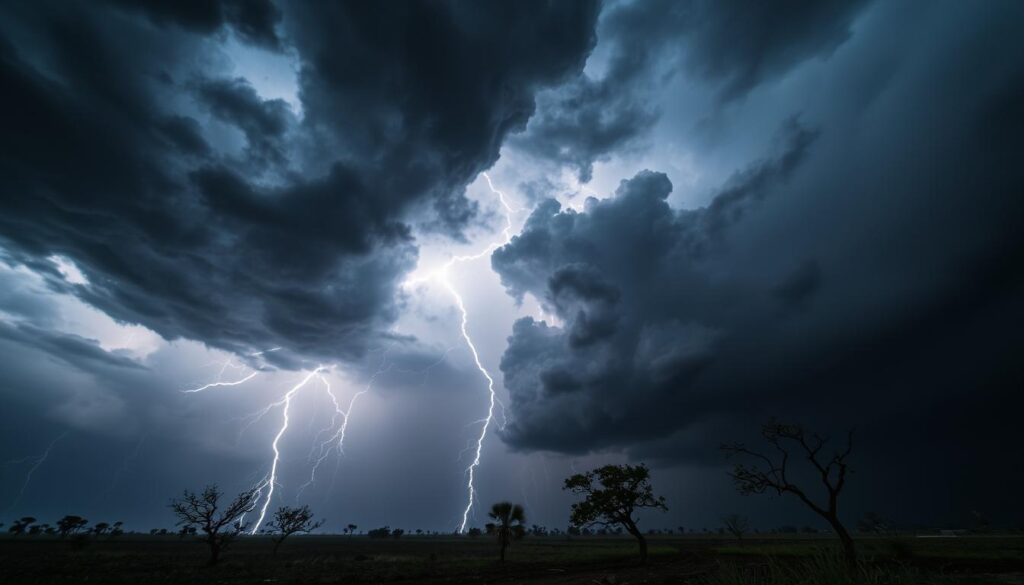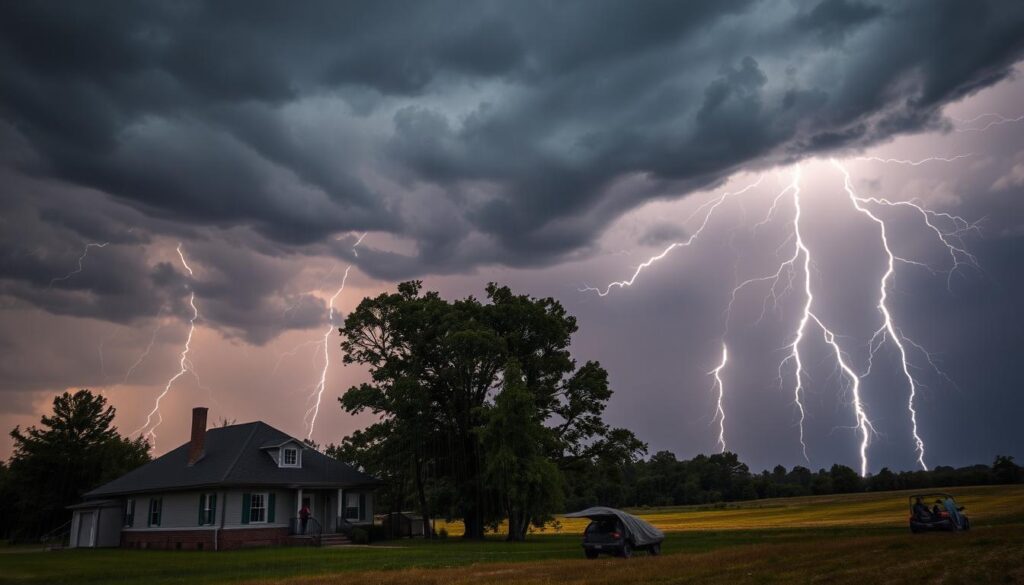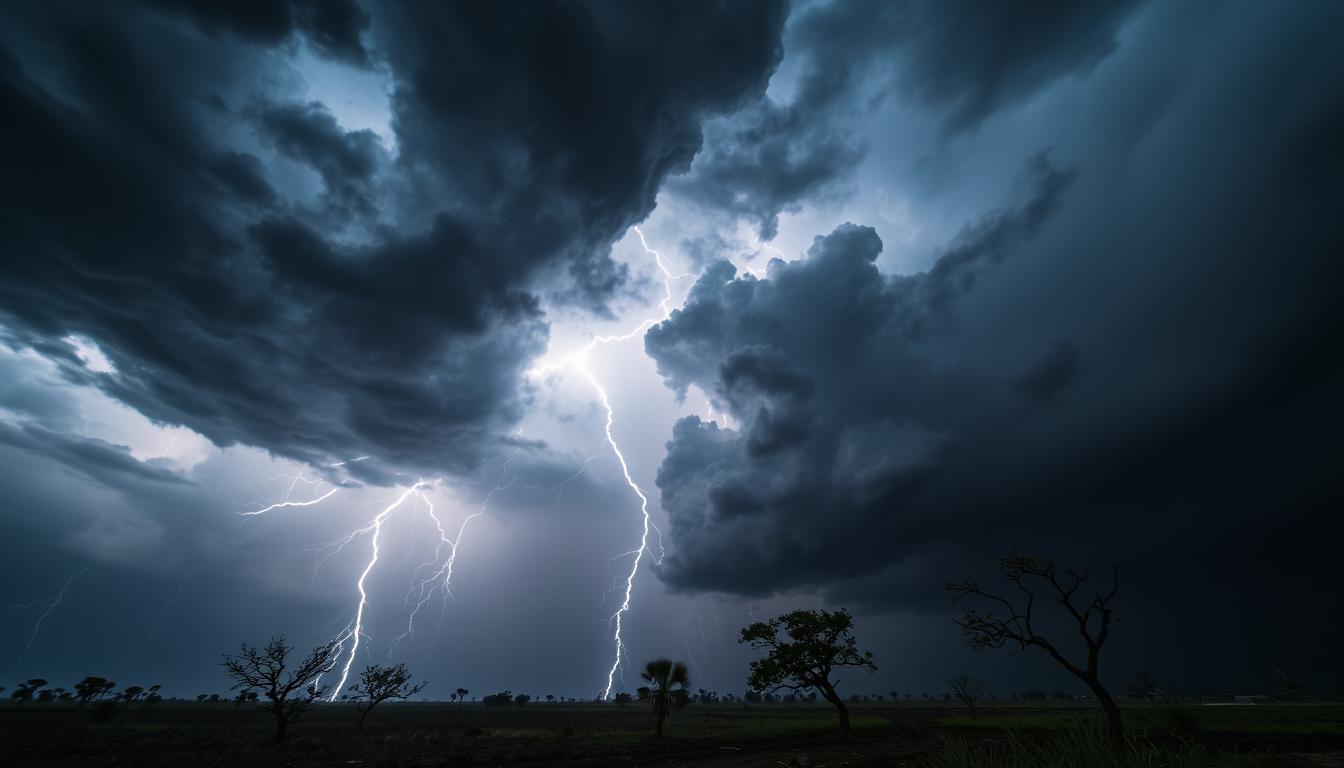Germany is under a severe thunderstorm warning, known as “warnung vor starkem gewitter.” This means intense thunderstorms, heavy rain, lightning, and strong winds are coming. It’s important for everyone to know what to do to stay safe.

A dark, ominous sky filled with swirling gray storm clouds, flashes of bright lightning illuminating the scene, heavy rain pouring down on a desolate landscape, strong winds bending trees and debris swirling in the air, a dramatic atmosphere capturing the intensity of a severe thunderstorm.
Key Takeaways
- Germany is under a severe thunderstorm warning, known as “warnung vor starkem gewitter.”
- This extreme weather alert signifies the impending threat of intense thunderstorms, heavy rainfall, lightning, and strong winds.
- Residents must stay informed and take necessary safety measures to protect themselves and their property.
- Monitoring local weather updates and heeding the warning is crucial during this severe storm event.
- Preparing an emergency plan and kit can help ensure safety and resilience during the thunderstorm.
Understanding Severe Thunderstorms
Severe thunderstorms can be dangerous, threatening life and property. They bring strong winds, heavy rain, and can cause lightning, hail, and tornadoes. Knowing what makes these storms severe helps us prepare and react quickly.
Defining Severe Thunderstorms
A severe thunderstorm is one that has winds over 58 mph (93 km/h), hail 1 inch (25 mm) or bigger, or a tornado. These storms can start fast and bring dangerous weather that needs quick action.
Identifying Thunderstorm Characteristics
Here’s how to spot a severe thunderstorm:
- Dark, towering clouds that go up to 60,000 feet (18,000 meters)
- Frequent lightning and the chance of hail, strong winds, and tornadoes
- A distinctive, anvil-shaped cloud top that shows the storm’s strength and severe weather risk
- Rapidly changing wind direction and speed, which may mean a rotating storm
Knowing what severe thunderstorms look like helps us protect ourselves and our families.
“Severe thunderstorms can produce a wide range of hazardous conditions, including high winds, large hail, and even tornadoes. It’s crucial to be prepared and stay vigilant when these storms are in the forecast.”
“Warnung vor starkem gewitter”: Heeding the Warning
When the German weather service issues a “warnung vor starkem gewitter,” or severe thunderstorm warning, it’s crucial for residents to act fast. This alert means a dangerous weather event is coming, and quick action is needed to protect lives and property.
The warnung vor starkem gewitter is serious. It warns of a severe thunderstorm with strong winds, heavy rain, hail, and possible tornadoes. These conditions are a big risk to safety, and ignoring the warning can lead to disaster.
“Heeding a thunderstorm warning is not an option – it’s a necessity. The safety of your family and community depends on your prompt response.”
When you get a warnung vor starkem gewitter, watch local news and weather closely for updates. Follow instructions from local authorities. This might mean going to a safe building, not traveling, and protecting your property from the storm,
The warnung vor starkem gewitter is not the same for everyone. The storm’s severity and length can change, so be ready to adjust your actions. Listen to local officials to keep you and your loved ones safe during the storm.
Preparing for Thunderstorm Emergencies
Severe thunderstorms require preparation. A detailed emergency plan and a well-stocked kit can help. These steps boost your readiness and safety during the storm.
Creating an Emergency Plan
Creating a plan is vital for severe weather safety. First, pick a safe spot in your home, like an interior room on the lowest floor. Make sure everyone knows where it is and how to get there fast.
Also, choose a meeting spot outside your home if you need to leave. Practice your plan with your family often. This ensures everyone knows what to do.
Assembling an Emergency Kit
A good emergency kit is crucial. Pack a flashlight, battery-powered radio, first-aid kit, extra batteries, and non-perishable food. Include clean water, important papers, medicines, and warm clothes too.
Keep your kit where you can easily get to it. Check it often to make sure everything is still there and usable.
| Emergency Kit Essentials | Recommended Quantity |
|---|---|
| Flashlight | 1 per person |
| Battery-powered radio | 1 |
| First-aid kit | 1 |
| Extra batteries | 1 pack per item |
| Non-perishable food | 3-day supply per person |
| Water | 1 gallon per person per day for 3 days |
By being proactive, you and your family can face severe thunderstorms better. Being prepared is key when severe weather hits.
Staying Safe During a Thunderstorm
When a severe thunderstorm hits, keeping safe is key. Follow thunderstorm safety tips and severe weather safety advice to lower injury risks during a storm.
First, find shelter quickly when a thunderstorm comes. Keep away from electrical gear and windows. If outside, crouch low with your feet together to reduce ground contact. Stay away from tall objects and water.
Stay inside until the storm ends. Don’t use corded phones as they can conduct electricity. Unplug big appliances and electronics, and skip showers or baths during the storm. Lightning can strike far from rain, so stay safe until it’s over.
- Seek immediate shelter when a thunderstorm approaches
- Avoid contact with electrical equipment and stay away from windows and doors
- Crouch low with feet together if caught outside
- Avoid tall, isolated objects and bodies of water
- Remain indoors until the storm has passed completely
- Avoid using corded phones, and unplug major appliances and electronics
- Postpone showers or baths during the storm
By using these thunderstorm safety tips, you can stay safe in a severe weather event. Always put your safety first when facing a thunderstorm.

A dramatic landscape showcasing a dark, stormy sky filled with ominous thunderclouds, vivid lightning strikes illuminating the scene, and heavy rain pouring down onto a rural setting. In the foreground, a sturdy house with reinforced windows and a safe basement entrance, surrounded by tall trees swaying in the wind. Nearby, an open field with a few people taking shelter under a sturdy shelter or inside parked vehicles, emphasizing the importance of seeking safety during severe weather.
“When thunder roars, go indoors. No place outside is safe when lightning is in the sky.”
Protecting Your Home and Property
When severe thunderstorms hit, it’s crucial to protect your home and outdoor items. Homeowners need to act fast to keep their property safe from high winds, heavy rain, and lightning strikes.
Securing Outdoor Items
It’s important to keep outdoor items from becoming flying objects in a storm. Bring in any loose furniture, plants, or decorations inside. Make sure lawn furniture, grills, and other items are either anchored or put away safely. This helps secure outdoor property and avoids expensive damage.
Safeguarding Your Home
To protect your home from thunderstorms, make sure it’s strong and ready. Check your roof for any loose or broken shingles and fix them. Clean your gutters and downspouts for good drainage. Think about getting surge protectors for your electrical stuff and trim any tree branches near your home.
| Outdoor Items to Secure | Home Safeguarding Measures |
|---|---|
| Lawn furniturePotted plantsDecorationsGrillsOutdoor equipment | Inspect and repair roofClear gutters and downspoutsInstall surge protectorsTrim overhanging tree branches |
By acting early to secure outdoor property and protect your home from thunderstorms, you can lower risks and damage. These home storm preparation steps offer peace of mind and protect your valuable things.
Extreme Weather Alert: Thunderstorm Intensity
The “warnung vor starkem gewitter” or severe thunderstorm warning in Germany shows the storm will be very intense. People should get ready for strong winds, torrential rainfall, and hail. These can be dangerous to both life and property.
How intense a thunderstorm is can be measured by wind speed, how much rain falls, and if there’s hail or tornadoes. Such extreme weather can cause a lot of damage and make power go out. It’s important for people to know what’s happening and stay safe.
The upcoming thunderstorm might bring winds of up to 70 mph, with gusts up to 90 mph. Rain could fall at more than 2 inches per hour, causing flash flooding in low places. Also, the storm might produce hail as big as golf balls, which can hurt buildings and cars.
“The combination of strong winds, heavy rain, and large hail can create a dangerous and life-threatening situation. It’s crucial that residents take this warning seriously and prepare accordingly.”
To stay safe during this extreme weather alert, experts suggest doing the following:
- Secure outdoor furniture, equipment, and loose items that could fly away in the wind.
- Don’t travel if you don’t have to and find a safe place in a strong building or car if you’re outside.
- Keep an eye on the news and weather for updates on the severe storm conditions.
- Turn off electronics and don’t use landline phones to avoid getting hit by lightning.
By being alert and taking steps ahead of time, people can help keep themselves and their things safe from the thunderstorm intensity coming soon.
Thunderstorm Warning: Potential Hazards
Severe thunderstorms bring many dangers. They can cause lightning strikes and even tornadoes. It’s important to know the risks to stay safe.
Lightning Strike Caution
Lightning is a big danger in thunderstorms. It can strike up to 10 miles away from where it rains, so it’s always a threat. If you’re outside, find shelter fast. Avoid open areas, tall objects, and water.
Stay inside, away from windows, and unplug devices. This can lower the risk of getting hurt by lightning.
Tornado Risk Update
- Thunderstorms can create tornadoes, which are very dangerous.
- It’s important to watch the weather closely and follow tornado warnings.
- Having a safe place, like a basement, can help you survive a tornado.
Being alert and ready is key to facing thunderstorm hazards, lightning strike danger, and tornado risk. Knowing these dangers and acting fast can keep you and your property safe.
Severe Storm Advisory: High Wind Speeds
The “warnung vor starkem gewitter” (severe thunderstorm alert) warns us of high wind speeds. These high wind speeds can be very dangerous. They might damage buildings, knock down power lines, and make it hard to go outside or travel.
Thunderstorms with severe storm winds can hit up to 100 mph (160 km/h). This is much faster than normal thunderstorms. Such winds can knock down trees, blow away objects, and even turn over cars. This is a big risk to everyone’s safety.
- Stay alert and watch the weather closely as the storm comes.
- Bring in any outdoor items, like patio furniture or plants, to stop them from flying away.
- Maybe change or cancel your outdoor plans until the storm is over.
- If you have to go out, be careful on the roads and be ready for power outages or debris.
“The strongest thunderstorms can produce wind gusts exceeding 100 mph, which is enough to cause significant damage to buildings and infrastructure.”
It’s important to get ready for and deal with the high wind speeds from severe thunderstorms. This helps keep you, your family, and your stuff safe. By staying updated, taking steps ahead of time, and listening to warnings, you can stay safe during the storm.
Intense Rainfall Notification: Flash Flood Alert
Severe thunderstorms can lead to intense rainfall, increasing the risk of flash flooding. It’s important for people to know their flood risks and act quickly to protect themselves and their property during a flash flood.
Identifying Flood Risks
Areas near rivers, streams, or low-lying land are more likely to flood. People should learn about flood history and dangers in their area. This helps them make smart choices during a flash flood.
- Find out if your home is near flood-prone areas.
- Keep up with local weather and flood warnings from authorities.
- Know the warning signs, like fast-rising or moving water, that mean a flash flood is coming.
Responding to Flash Floods
If a flash flood alert is given, act fast to keep yourself and your loved ones safe. Following advice from local authorities is key to staying safe during a storm.
- Leave immediately if told to do so by officials, and use the recommended evacuation routes.
- Don’t try to drive or walk through flooded areas, as the water can be deep and dangerous.
- Move to higher ground, like the second floor of a building or an elevated spot, to avoid being swept away.
- Keep an eye on local media and official channels for updates and more instructions.
Being prepared and responding right to flash flood alerts can greatly lower risks and keep your family and community safe.
Hail Storm Warning: Protecting Yourself
Severe thunderstorms can bring hail, which is a big risk to both property and people. It’s key to be ready to find shelter and protect yourself when a hail storm hits.
When a hail storm warning comes, finding safe shelter is crucial. Move inside, away from windows and doors, and go to a strong building or basement if you can. Don’t try to stay in cars because hail can hurt them and leave people at risk.
Once you’re safe, make sure you and your loved ones are protected. Wear things like hard hats, goggles, and thick clothes to avoid getting hurt by hail. Keep flashlights and a battery-powered radio ready to get updates on the storm and any emergency advice.
Protecting your property is also vital. Tie down outdoor items like patio furniture, plants, and decorations to stop them from flying around in the storm. Think about getting impact-resistant windows or storm shutters to keep your home safe from hail.
Being ready and taking the right steps can really lower the risks of a hail storm. Always be alert, find shelter, and protect yourself and your stuff to get through the storm safely.

A dramatic landscape showcasing an intense hail storm, with dark storm clouds swirling in the sky, large hailstones falling from above, and a rural setting with an old barn and trees bending against the wind. The ground is covered in a layer of ice pellets, reflecting flashes of lightning illuminating the scene.
| Hail Size | Potential Damage |
|---|---|
| Pea-sized (0.25 inches) | Minor damage to plants and vehicles |
| Dime-sized (0.75 inches) | Damage to roofs, windows, and exposed outdoor items |
| Golf ball-sized (1.75 inches) | Significant damage to homes, vehicles, and crops |
| Baseball-sized (2.75 inches) | Severe damage to buildings, vehicles, and infrastructure |
Remember, the main way to stay safe in a hail storm is to be ready and act fast to protect yourself and your property. By doing these things, you can face the storm with more confidence and safety.
Conclusion: Staying Vigilant and Prepared
Severe thunderstorms require our full attention and readiness. When the “warnung vor starkem gewitter” sounds, we must act quickly to protect ourselves and others. By keeping up with weather news, following safety tips, and watching the situation closely, we can handle these storms with ease.
Being ready for thunderstorms is key to our safety. Making emergency plans, putting together kits, and securing our homes and belongings are important steps. Being alert and flexible when the weather changes is how we stay safe during these storms.
Even though severe thunderstorms are scary, we can feel secure knowing we’re ready. By staying informed, prepared, and flexible, we can get through any storm. With resilience and teamwork, our communities can come out stronger, ready for whatever the future brings.
FAQ
What is a “warnung vor starkem gewitter”?
A “warnung vor starkem gewitter” is a warning for severe thunderstorms in Germany. It warns of intense storms with heavy rain, lightning, and strong winds. This alert helps people stay safe by knowing what to do.
What are the characteristics of severe thunderstorms?
Severe thunderstorms have strong winds, heavy rain, and can bring lightning, hail, and tornadoes. They are dangerous and can harm people and buildings. Knowing about these storms helps people prepare and stay safe.
Why is it important to heed the “warnung vor starkem gewitter” warning?
The “warnung vor starkem gewitter” warning is very important. It means a dangerous storm is coming. People should act fast to keep themselves and their things safe.
How can I prepare for a thunderstorm emergency?
To get ready for a severe thunderstorm, make an emergency plan and gather important supplies. This way, you and your family can handle the storm better.
What safety precautions should I take during a thunderstorm?
During a storm, keep yourself safe by finding shelter and avoiding electrical things. Stay away from windows and doors. These steps can help you stay safe.
How can I protect my home and property from thunderstorms?
To protect your home, secure outdoor items and make sure your house is ready for the storm. This includes protecting your home’s structure and systems from wind, rain, and lightning.
What are the potential hazards associated with severe thunderstorms?
Severe storms can be dangerous, with lightning and tornadoes being major threats. Knowing these risks helps you protect yourself and your loved ones.
How can high wind speeds from thunderstorms affect my property?
High winds from storms can damage your property, knock down power lines, and make it hard to go outside or travel. The “warnung vor starkem gewitter” warns you of this danger.
What should I do in the event of a flash flood warning?
Flash floods can happen with heavy rain from storms. Know your flood risk and act fast to keep safe and protect your property.
How can I protect myself from hail during a thunderstorm?
Hail can be a big problem in storms. It can hurt people and damage buildings. Make sure you have a plan to stay safe during a hail storm.

